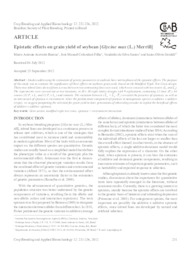Epistatic effects on grain yield of soybean [Glycine max (L.) Merrill].
Epistatic effects on grain yield of soybean [Glycine max (L.) Merrill].
Author(s): BARONA, M. A. A.; COLOMBARI FILHO, J. M.; SANTOS, V. da S.; GERALDI, I. O.
Summary: Studies addressing the estimation of genetic parameters in soybean have not emphasized the epistatic effects. The purpose of this study was to estimate the significance of these effects on soybean grain yield, based on the Modified Triple Test Cross design. Thirty-two inbred lines derived from a cross between two contrasting lines were used, which were crossed with two testers (L1 and L2). The experiments were carried out at two locations, in 10 x 10 triple lattice designs with 9 replications, containing 32 lines (Pi ), 64 crosses (32 Pi x L1 and 32 Pi x L2 ) and controls. The variation between ( L li + L 2i - P i ) revealed the presence of epistasis, as well as an interaction of epistasis x environment. Since the predominant component of epistasis in autogamous species is additive x additive (i type), we suggest postponing the selection for grain yield to later generations of inbreeding in order to exploit the beneficial effects of additive x additive epistasis.
Publication year: 2012
Types of publication: Journal article
Unit: Embrapa Rice & Beans
Observation
Some of Embrapa's publications are published as ePub files. To read them, use or download one of the following free software options to your computer or mobile device. Android: Google Play Books; IOS: iBooks; Windows and Linux: Calibre.
Access other publications
Access the Agricultural Research Database (BDPA) to consult Embrapa's full library collection and records.
Visit Embrapa Bookstore to purchase books and other publications sold by Embrapa.

